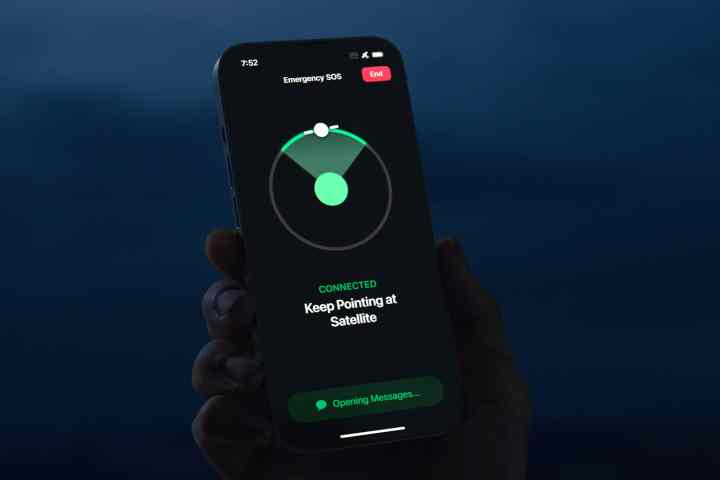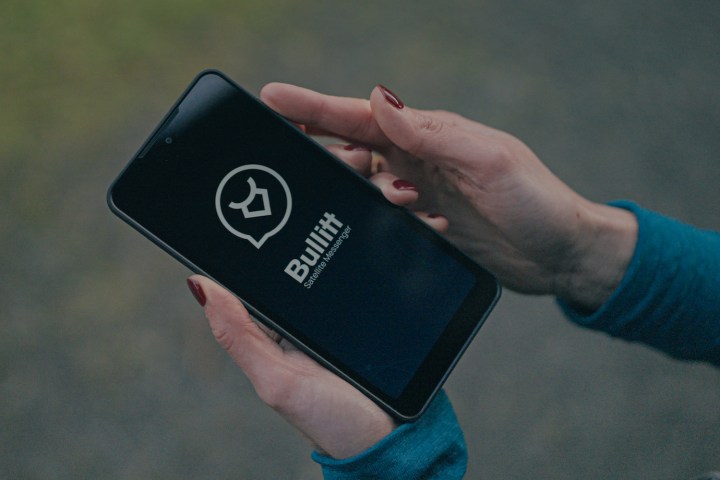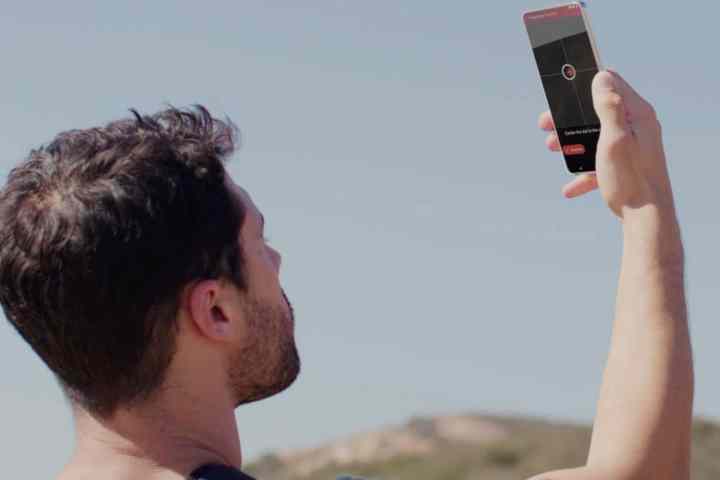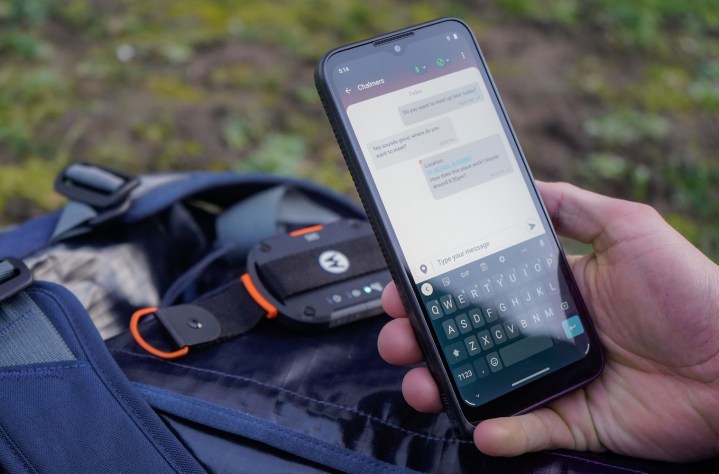Two companies are approaching one of the hottest current mobile trends, satellite communication, in a different way than Apple — with the goal of opening it up to be more useful to more people. The efforts could potentially pave the way for a new way to communicate using our phones that is as easy to use and as ubiquitous as SMS and WhatsApp.
While the iPhone 14 series can use satellites to message for help in an emergency when normal cellular coverage is unavailable, the Bullitt Group and MediaTek are expanding this functionality to include SMS-style two-way messaging over satellite to keep people in touch with family, safe in the event of an accident, and plenty more — even when their phone doesn’t have any signal.
To understand just how much of a difference the new service could make to people, Digital Trends spoke to MediaTek and the Bullitt Group ahead of the launch of the Bullitt Satellite Messenger app, the Cat S75 and Motorola Defy 2 phones, the Motorola Defy Satellite Link dongle, and MediaTek’s MT6825 chip.
How it’s different from Apple’s approach

First, let’s examine the technology behind this alternative push into satellite communications, and provide an introduction to the companies behind it. The Bullitt Group is best known for its rough-and-tumble smartphones made under license for brands such as Cat and Land Rover. The British manufacturer has recently partnered with Motorola to build the new Defy 2 phone, announced during CES 2023, which joins the new Cat S75 as the first devices with its Bullitt Satellite Messenger app preinstalled.
Semiconductor company MediaTek makes chips for a massive array of products, from smartphones to smart speakers. Its latest release is the MT6825, a dedicated chip fitted to the new Cat and Motorola phones that enables two-way, text-based communications using satellites. Along with messaging, it also has emergency SOS communication, location sharing, location tracking, and weather forecasting.
Unlike Apple’s emergency-only, Low Earth Orbit (LEO) satellite communication system on the iPhone 14 and iPhone 14 Pro, MediaTek’s MT6825 chip works on the open 3GPP NTN standard, which the company has been helping shape since 2018, and connects to Geosynchronous Equatorial Orbit (GEO) satellites. The chip automatically checks for text-based messages, takes very little power from the phone, doesn’t need the phone to be “aimed” anywhere in particular, and isn’t a hugely expensive addition to a device for manufacturers.
The Bullitt Satellite Messenger app is actually satellite agnostic, and while it uses GEO satellites at the moment, it can also connect to LEO satellites, and this functionality may be introduced in the future (along with a whole lot more). The MediaTek chip works independently of the modem inside a phone, and can even be added to devices without a modem at all. The app and chipset work together to make satellite communication possible and accessible to anyone. But why would you want it?
More than just emergency use

Tim Shepherd, Bullitt Group’s senior director of applications and product marketing, is very passionate about the potential of true two-way messaging when regular cellular networks aren’t available. He spoke in detail about its potential, but began by talking about the constraints of normal cellular network coverage:
“If we look at the [connectivity] story across Europe, 85% [of the landmass] is covered, which is pretty high,” he said. “But in a lot of other markets, it’s closer to 80% or 75%, and then you go to the U.S., where 68% to 70% of the landmass is covered. Canada is only 30% and Australia’s about 30% too. So you can see there’s a proposition here in Europe, but also as you go further afield to the Americas, Australia, and places like that, the proposition only grows in terms of its potential.”
What this is about is filling those gaps.
In that context, the usefulness of satellite communication in the event of an emergency is obvious, but what the MT6825 and the Bullitt Satellite Messenger app can do goes way beyond this. Shepherd continued:
“What this is about is filling those gaps. It’s about providing security when cellular and Wi-Fi are not available, to send messages whenever they’re important. It’s about delivering peace of mind not only to the user themselves in terms of their ability to stay connected with friends and family, but to update on changing plans, to reassure people that you’re OK, that you’re getting on with your job or progressing through your day of activities as planned, or to raise the alert when you need it. It’s also about peace of mind for those receiving the message. Whether that’s a loved one, a friend or family member, or a co-worker who’s relying on you to deliver a piece of work. Peace of mind is certainly going to be a big motivator here.”
How does satellite texting work?

This is a two-way satellite communication system, but messages aren’t sent or delivered to your normal SMS inbox. Instead, it all works through the Bullitt Satellite Messenger app, which will be available for an Android or iOS phone, whether the device has satellite connectivity or not. Shepherd explained the journey of a message from the app:
“Every time a message is sent from the service, it looks to see if there is Wi-Fi or cellular coverage. If not, then it connects to a satellite, and effectively, that message flies 22,000 miles over the Earth and back down to our cloud infrastructure. At that point, we make a decision from a routing perspective: is that going back up over satellite to another user connected to satellite, or more likely, it’s going to be delivered to [a network-connected] iOS or Android device.”
If the recipient doesn’t have the Bullitt Satellite Messenger app, they will receive a regular SMS message informing them and prompting them to download the app. It’s a free account, and according to Shepherd, the only time any payment is involved or a subscription plan is needed is when you connect to satellite coverage. In other words, if you’re safely home on Wi-Fi or cellular, messages will be free to send back through the app.
Satellite communications through the Bullitt Satellite Messenger app won’t only be relevant to people who are completely “off the grid.”
The only real technical restriction is a hard limit of 140 characters for messages. For emergency communications, Bullitt is working with FocusPoint International, and the app will connect you to one of its response centers in the event you need help. Immediately after opening the emergency SOS feature, your location is shared and basic triage questions are asked. Emergency situations can be escalated by FocusPoint International, and messages can be sent to your emergency contacts too.
The flexibility and relatively low cost — the service starts at $5 per month — means satellite communications through the Bullitt Satellite Messenger app won’t only be relevant to people who are completely “off the grid” in a traditional sense. Shepherd envisages it being used by people in rural areas with patchy cellular coverage, workers in remote areas, and hobbyists out in the wilderness for the weekend.
Does Bullitt want to become a carrier?

While Bullitt has developed apps and software before, such as its thermal imaging system with Flir, the Bullitt Satellite Messenger app is its first at this level. Is it the start of something completely different for the company?
“Our ambition is not to become the next WhatsApp,” laughed Shepherd. However, as he continued talking, it became clear Bullitt doesn’t want to restrict the app to only being preinstalled on phones it has built, and that any comparison to WhatsApp may not be thinking big enough.
“You could come to us and say, hey, look, we’ve used the MediaTek MT6825 chipset, and we’d like to license your end-to-end solution [meaning the app and associated account and backend technology], and we could license it to other customers pretty easily. Our ambition is very much about enabling, supporting, and accelerating satellite communications, and bringing it to market rapidly.”
Licensing is just the beginning, and Bullitt’s plans make the future of satellite communication on our phones far more exciting. Bullitt isn’t satisfied with two-way SMS and emergency SOS functionality through satellite communications, and is looking ahead at developing and introducing more features, as Shepherd revealed:
“We have a road map forward for how we get to things like voice, how we get to multimedia messaging, and ultimately how we get towards 5G radio and true data services over satellite. That’s two or three years out, but we’ve built this with a view to how we continue to enhance, improve, and develop the technology to get to where we want to be, which is a full and rich set of data services.”
Will satellite communications become ubiquitous?

Satellite communications is a current trend, and both Bullitt and MediaTek have invested considerable time, effort, and money into developing it into a service that can potentially be relevant to a surprisingly large amount of people. Plus, it can be safely assumed that any feature that appears on an Apple device will be viewed as desirable by other phone makers. Does this mean satellite communication is about to become as ubiquitous as a feature like Bluetooth?
We asked MediaTek’s vice president of corporate marketing, Finbarr Moynihan, if the company expects satellite communications through its MT6825 chip, or future variants, to become a feature we see on most phones?
“Our view right now is it’s still somewhat of a niche application today,” he told Digital Trends. “I think for the next maybe two years or so, like 2023 or 2024, maybe even into 2025, it’ll still be relatively niche. Not going into every phone, but more specialized phones in certain segments will probably continue to add it.”
However, echoing Shepherd’s outlook on the future of the technology, Moynihan sees this changing when it evolves, and when more functionality is added:
“[When] NR NTN technology is integrated into 5G modems at some point in time, [satellite communication] will be a more integrated part. Naturally, that will probably start at the high end and trickle down over time. But at some point, I think most phones will be able to add this capability with limited additional cost. Then there’s the service model that goes on top of that, which may mean that in the next couple of years, it becomes a feature that’s capable on most phones, and somebody can activate the service if they want it. We still think that’s going to take a few years with the satellite constellations that have to be built, and the standardization that has to be done. We feel our approach at the moment of an external chip that allows you to add it on is probably the most logical.”
Fast-paced, and ready for the future

Before late last year, many people will only have seen satellite communication used in movies. But over the course of just a few months, it has arrived in the iPhone 14 as an emergency-only service, Qualcomm has introduced Snapdragon Satellite (which is also a two-way satellite communication system) and its Snapdragon X75 modem, and now Bullitt and MediaTek have a complete two-way messaging system, a pair of smartphones, and a dongle so anyone with the app can use it.
While mainstream adoption seems to be unlikely right now, given the pace with which additional functionality and usefulness have already been introduced, it may not be long before satellite communications on our phones will be as common as any other connectivity technology such as NFC, Wi-Fi, and Bluetooth — and even more useful than SMS.
Editors' Recommendations
- I tried a lifesaving gadget that’s going to transform your phone
- This new Android phone is unbelievably tough — and it talks to satellites





